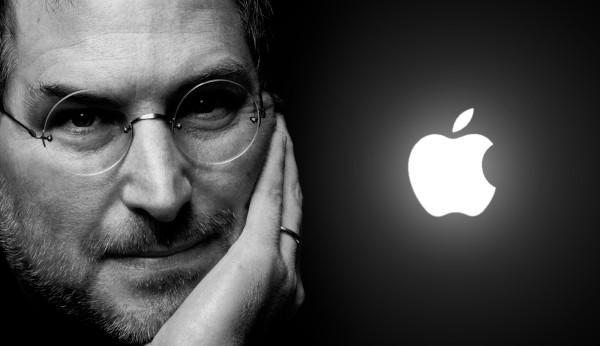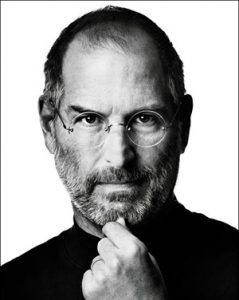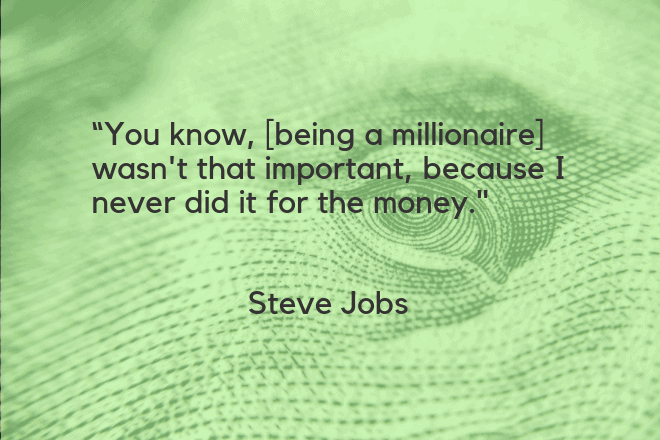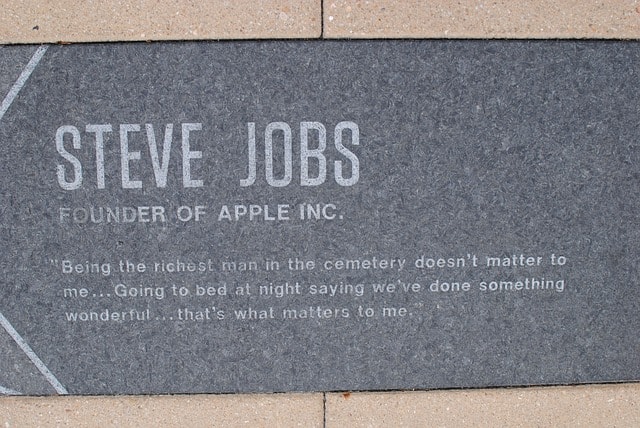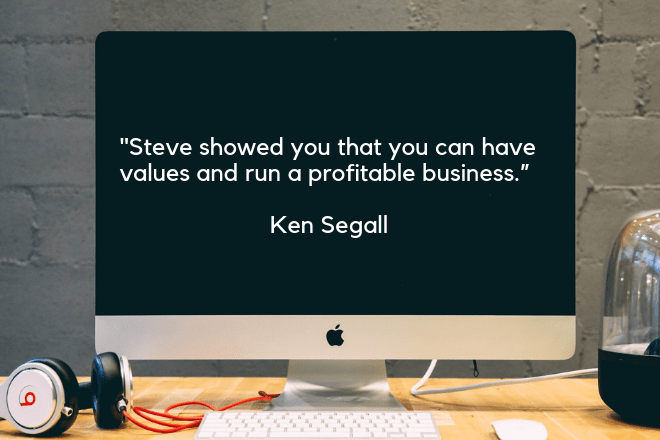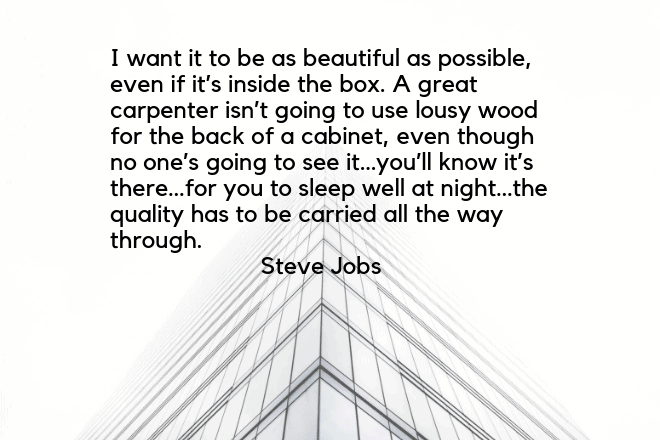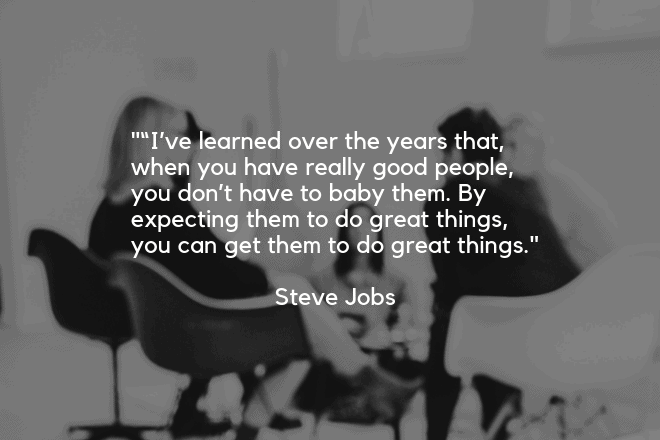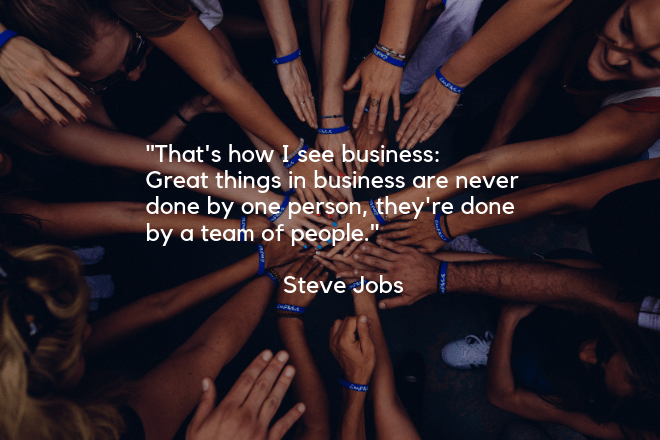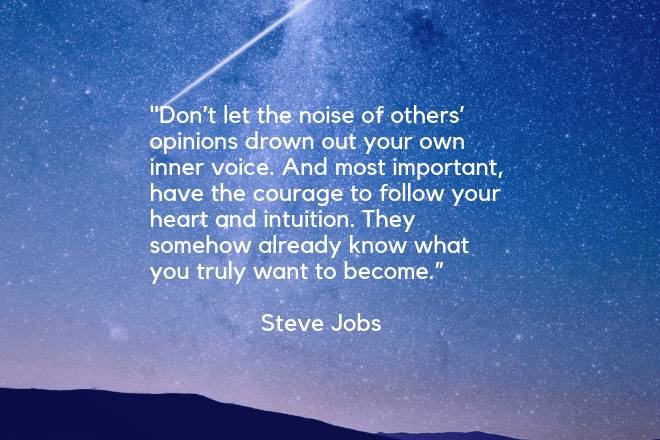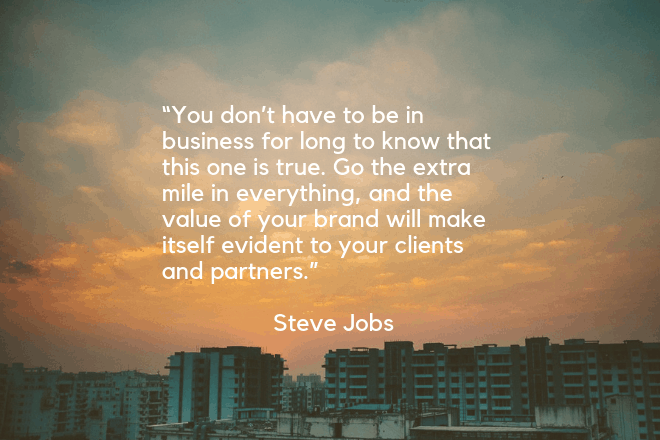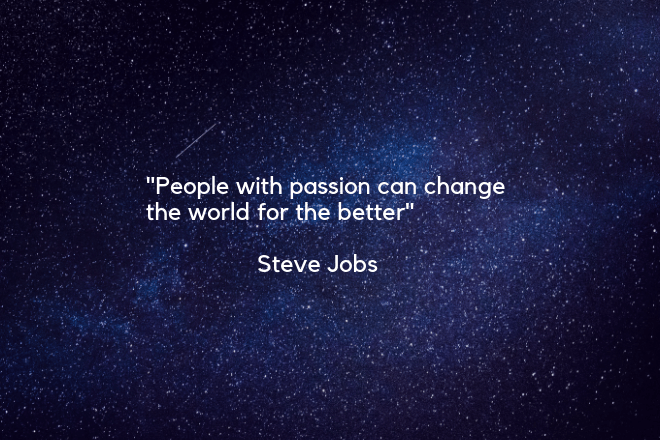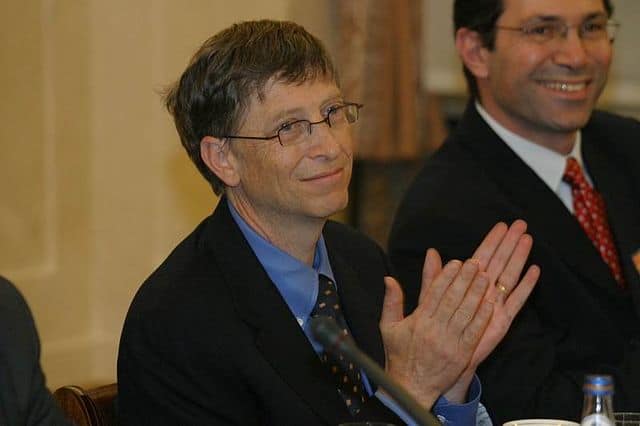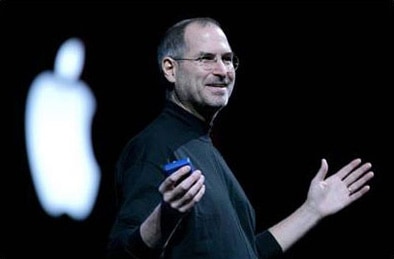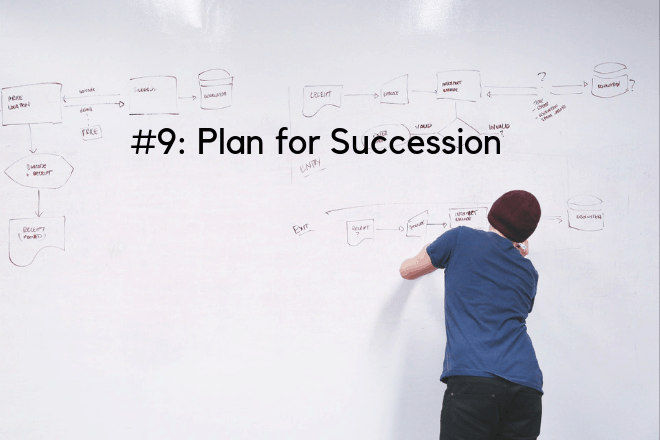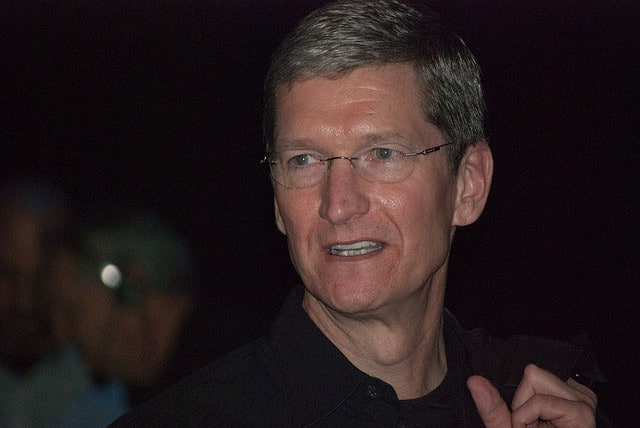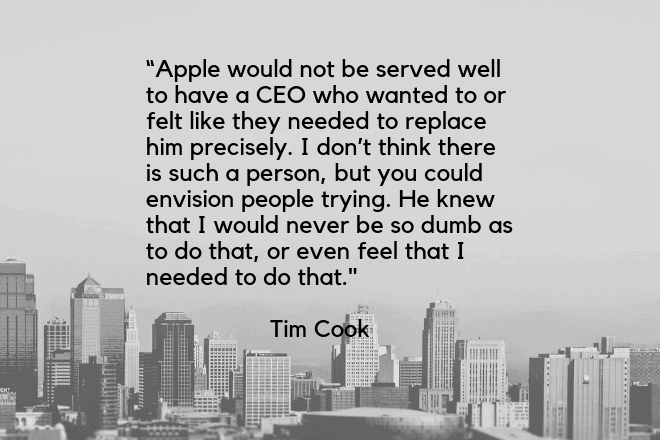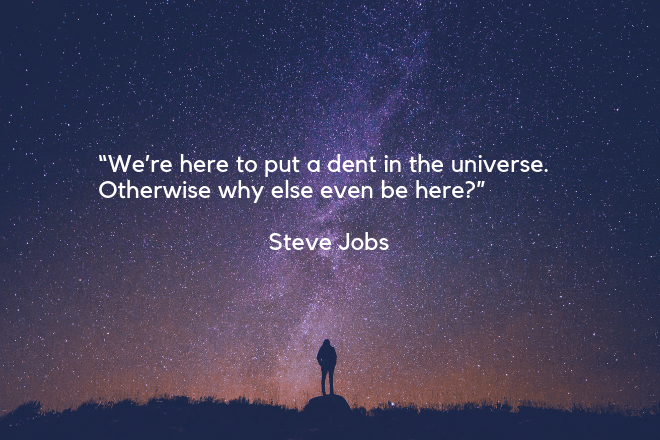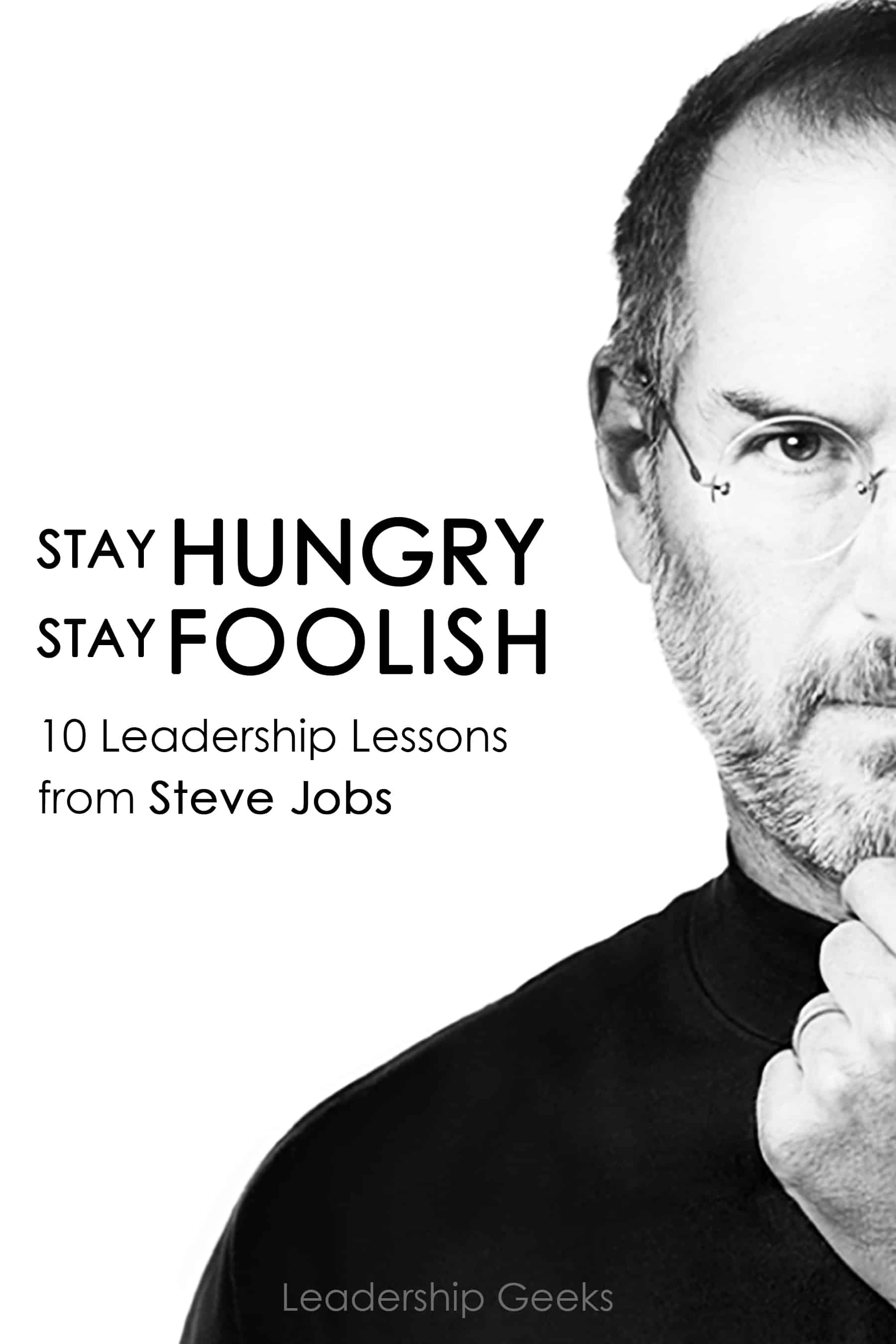Steve Jobs left behind an incredible legacy: From computers and technology, to music and movies, his influence and innovations revolutionized industries. They continue to shape how we consume information and entertainment, achieve productivity, and communicate with each other in modern times.
With his success in leading Apple, NeXT, and Pixar, there is much we can learn from Steve Jobs as a leader and trailblazer.
In the following sections below, we will look at the 10 most important leadership lessons and traits that can be gleaned from the experiences and enormous successes of Steve Jobs. We will delve into the choices he made as a business mogul in order to better understand how his passion and dedication to his craft can be emulated by anyone looking to enhance their own leadership skills.
NOTE: This post was originally planned to be released as a book, but we decided to release it for FREE here on Leadership Geeks. It’s pretty long — more than 10,000 words actually! So if you’d rather download a nice PDF of it that you can read later offline, you can Buy the PDF here for just $3. It also helps support our site! 🙂
(Updated April 2019)
The Leadership Style of Steve Jobs:
The Top 10 Leadership Traits of the Man Behind Apple, NeXT, and Pixar
Table of Contents
1. Don’t Do It for The Money
Our materialistic society places a premium on financial success. The bigger your salary, the nicer things you can afford, and the more successful you will be considered in your chosen field. While it is not wrong to aim for material success (Steve Jobs, after all, was himself a very wealthy man), doing everything primarily for monetary gain often creates a lifestyle characterized by greed, loss of ideals, and a lack of real fulfillment.
If there is anyone who knows exactly what material success feels like, it is Jobs. He was already a millionaire at the age of twenty-three. His net worth was about ten million dollars at age twenty-four, and this had grown exponentially to a hundred million dollars by the following year. Jobs was one of the youngest ever to make it to Forbes’ list of the richest people. Even more impressive is the fact that he did this without any inherited wealth. By the time he passed away in 2011, his net worth was around $10.2 billion.
Yet, in a 1995 interview, Jobs had this to say:
“You know, (being a millionaire) wasn’t that important, because I never did it for the money. I think money is a wonderful thing, because it enables you to do things. It enables you to invest in ideas that don’t have a short-term payback. At that time in my life, it was not the most important thing. The most important thing was the company, the people, the products we were making. And what we were going to enable people to do with these products. So I didn’t think about the money a great deal. I never sold any stock. I just believed that the company would do very well over the long term.”
Money is a Tool
Jobs understood that money is neutral. It can enable you to achieve more and make a difference in your spheres of influence. However, money is not the most important thing. Jobs realized early on that it is the people he was working with along with their collective efforts towards groundbreaking consumer products that would eventually give them more satisfaction and a sense of achievement. He was focused more on the pursuit of excellence and the unique experiences of daily life, rather than the fleeting enjoyment that money may bring.
So many people give up their passion or real interests in exchange for a chance to land a more lucrative job or an established career, too often doing work that hardly gives any real fulfillment. The paycheque may be fat, the bank account may be full, but the soul becomes dry, and the spirit soon becomes exhausted from the tedium of it all. On the outside, it may seem like the idealized success story, but a closer look reveals a life that lacks real substance.
Passion Trumps Money
Steve Jobs had a passion for the wonders of technology and how it can change the world positively. He found a way to channel this passion into a moneymaking venture. Soon, his ideas became reality. Money was pouring in, but he never lost the passion or excitement he had from the very beginning. In fact, it is reported that even when he was very ill and lying in a hospital bed, he was thinking up devices to hold up an iPad in a hospital bed, and proposing ways the oxygen monitors could be better designed.
This leadership trait focuses on the invaluable importance of passion, talent, and creativity over the prospect of a quick buck. Are you making decisions based only on financial returns without regards to the potential impact it may have on the people you work with? Or based on how they may view their role in your organization or enterprise? Are you weighing the advantages of accepting a job offer based on the increase in salary, without any thought to drawbacks such as spending less time with your family.
Finding Meaningful Work
People and relationships are ultimately more important than any other material returns. However, too often we get so enamoured by the promise of wealth and social status that we become willing to give up the more important things in life. As a leader, your mindset must be one that places a premium on the person rather than production.
When money becomes the driving force for all priorities, we lose sight of how much more real and meaningful life can be beyond any material gain. Let your passion and natural inclinations lead you to a career path that is truly suited to who you are as a person instead of mapping out a path with only financial rewards as motivation. In the end, the happiness of seeing your achievements come to life will bring you more satisfaction, beyond anything money can purchase.
Steve Jobs believed it was important for an individual to find what he or she loves, both personally and professionally. Work takes up a major chunk of an individual’s life, and the only way he can be satisfied is to believe the work he is doing is great work. The only way to be able to do great work is to love what you do. If you haven’t found what you love, then keep looking for it. You shouldn’t have to settle; you will eventually find it. Steve Jobs once said that “your time is limited, so don’t waste it living someone else’s life”. Have the courage to do what you love and listen to your intuition.
After a hiatus of nearly 12 years, Jobs returned to Apple in 1997. At that time, Apple was close to bankruptcy. Jobs held a staff meeting, where he explained how important passion was in restoring Apple to its former glory. He said “people with passion can change the world”, and this simple idea is the key to success. In a speech given by Jobs at Stanford University in 2005, he said, “You’ve got to find what you love” and the only way in which you will be able to do great work is to love what you do.
If you aren’t passionate about your own ideas, no one else will be. All successful entrepreneurs are passionate, but it doesn’t necessarily have to be about the product. They can be passionate about their mission, about the influence their products or services have on other’s lives, or they might even be passionate about changing the world. For instance, Steve Jobs was never passionate about computer hardware. Instead, he was interested in developing tools to help people unleash their true creativity. He wanted to enrich the lives of those around him through technology.
Jobs was truly obsessed with design, to the extent that he took a calligraphy course to learn it. He believed that a person should follow their heart and have faith that everything will make sense in the future. Even after he was diagnosed with cancer, Jobs returned to Apple to complete projects that were dear to him. His passion and commitment is the primary reason he proved to be such a great leader and inspiration to many.
2. Set Impossibly High Standards
Whether it is the people he worked with, the products he designed, or his goals for his various ventures, Steve Jobs always raised the bar so high that it often seemed impossible to achieve. While modern culture celebrated mediocrity by accepting the status quo, Jobs strove for something more and the market loved him for it. They knew they were getting more than what the competition could give. The high standards Jobs set for himself became the benchmark for every company he led – Apple, NeXT, Pixar – and the results were obvious.
Jobs, the Perfectionist
It is said that the design team at Apple, the Human Interaction team, had to meet with Jobs every other weekend to present their ideas. Jobs, ever the perfectionist, would usually critique their proposals, ask for a do-over, and have them evaluated again in the same meeting two weeks later. It was constant pressure on the employees, so much so that Steve Wozniak, who co-founded Apple with Jobs, commented that many former employees have said they would never want to work with Jobs again.
However, this constant stress to improve undoubtedly pushed many of these Apple employees to raise their own standards. As a result, Apple products were regarded as among the best in the industry. Jobs’ perfectionism may have turned off many employees who could not stand the pressure, but those who stayed and endured eventually became a part of the Apple technology revolution.
Ken Segall, a former creative director at Apple, who also worked with an ad agency for NeXT, described Jobs as “a client with absurdly high standards”. Segall is the man who coined the ‘i’ in iMac, which is now in many other Apple products such as the iPod and iPhone. He was also behind the famous Super Bowl commercial in 1999 about Apple and the Y2K bug. He goes on to say about Jobs:
“When it came to products, he believed in putting customer experience above all other things. When we had to run multi-page ads, we would have to choose the paper that the ads were printed on. Steve believed because people were going to love the experience of the ad, they would buy more Apple products as it gave them such a high quality. So, Steve showed you that you can have values and run a profitable business.”
Walking the Talk
Instead of just giving directives, exceptional leaders promote a high standard of excellence by ‘walking the talk.’ The reason why Jobs’ insistence on excellence became part of the culture in his companies is because he also endeavoured to live up to these ideals. People working with him knew he wasn’t exempt from his own high expectations.
In his biography of Steve Jobs, Walter Isaacson also wrote about the very high personal standards Jobs set:
“From his father Steve Jobs learned that a hallmark of passionate craftsmanship is making sure that even the aspects that will remain hidden are done beautifully… ‘I want it to be as beautiful as possible, even if it’s inside the box. A great carpenter isn’t going to use lousy wood for the back of a cabinet, even though no one’s going to see it…you’ll know it’s there…for you to sleep well at night…the quality has to be carried all the way through.’”
Living Up To Your Own Standards
For many of us, excellence may be something we aim for in the workplace or with colleagues, but these standards are set aside when we’re left alone. How often have you cut corners when no one was looking, or let something slide that otherwise you would not have done had someone been there to scrutinize your work? Jobs’ standard for himself was such that even when no one was around, he insisted on excellence down to the smallest detail.
How you set your personal and professional standards does not need to be an exact replica of Jobs. The standards we set for ourselves are shaped by our backgrounds, influences, and environment. The people we work and interact with constantly will either push us to aim higher or lower. Do those with whom you surround yourself challenge you, or are you finding yourself settling for less because your environment overlooks mediocrity or prioritizes quantity over quality?
Leaders sometimes confuse high standards with rigid, unrealistic codes of conduct or expectations, which is not always correct. What may constitute as “very high” standards for one group may be considered as inferior or insufficient to another. In addition, just because you may think you are strict doesn’t necessarily mean the rules themselves set any reasonably high standards for your organization.
A true leader recognizes that without clearly set standards for performance and excellence in areas of importance, a team will not achieve its full potential. High standards challenge stakeholders to bring their ‘A’ game and come fully prepared. In this area, Jobs clearly embodied a leader who not only set the bar for excellence, but also passed it along to those around him, causing a trend that eventually became the dominant culture in his companies.
3. Hire The Best
In the business world, securing the top talent for your team is a factor that can determine whether or not the venture will succeed. Steve Jobs recognized the necessity of working with staff who are the best at what they do. These are employees who can contribute not just skills and experience, but ideas that will push the organization forward and keep them ahead of the competition.
Jobs once famously quipped, “It doesn’t make sense to hire smart people and tell them what to do; we hire smart people so they can tell us what to do”. He understood that in order to get the most out of his employees’ potential, he needed them to not just perform a role, but also to actively share their opinions, feedback, and vision for improving the company.
Jobs emphasized hiring the very best of the best. He was directly involved in the hiring process and was said to have personally interviewed around 5,000 applicants. This means he was acutely aware of what hiring entailed and how to determine which potential recruits were the best candidates to join his team.
This also underscores how much of a perfectionist Jobs really was. He took time to really build a team that could challenge him and have the same passion he had for innovation. In his autobiography, Jobs says:
“I’ve learned over the years that, when you have really good people, you don’t have to baby them. By expecting them to do great things, you can get them to do great things. The original Mac team taught me that A-plus players like to work together, and they don’t like it if you tolerate B-grade work.”
The Ideal Team
While much can be said about the incredible vision, intellect, and innovative spirit of Steve Jobs, he has constantly credited much of his success to the collaborative efforts of his team. He once said, “the secret of my success is that we have gone to exceptional lengths to hire the best people in the world.”
A true leader recognizes the invaluable contributions the people around him can give towards the success of the company or organization. He will work to make the hiring process one that is laser-focused on securing talented, driven, and committed individuals who display top-notch skills and the hunger to learn more.
The ideal team consists of members who each have their own strengths and unique skills to contribute. An effective leader recognizes how to harness these varied skills toward a common goal. He also encourages questions and arguments that push each team member to deliver their best at all times, knowing that the others in the group will expect nothing less.
Why is it important to hire the best? You will be spending a lot of time with your team: conversations, planning sessions, proposal meetings, and product launches. Circumstances will either bring out the best in each of you, or hinder you from moving forward as a team towards bigger goals.
Jobs described it best:
“My model for business is The Beatles. They were four guys who kept each other’s kind of negative tendencies in check. They balanced each other, and the total was greater than the sum of the parts. That’s how I see business: Great things in business are never done by one person, they’re done by a team of people.”
Hiring The Best For Your Company
For most managers, hiring people isn’t something they are required to do, so they aren’t interested in investing their time in refining a management skill they don’t use. Steve Jobs thought otherwise. Hiring the best of employees is integral for improving the overall productivity of the company. Accurate hiring also helps in employee retention and engagement.
In the end, it pays to surround yourself with people who have positive attitudes, and are anxious to grab the next opportunity or discover the next big thing. Their energy will rub off on everyone in the team, and that excitement can be translated positively into effective action that keeps your group a step ahead of the pack.
Leaders should not be scared or intimidated by people who seem too confident, or have the potential to overshadow their own abilities. Rather, a wise leader, such as Steve Jobs, knows that the more he is able to work with the best, the higher his chances will be in improvement, innovation, and becoming the industry leader.
4. Practice Innovation
History is full of stories of trailblazers who dared to dream bigger than their peers and did not stop until they fulfilled their ambition for change. In the areas of science and technology alone, the names of Thomas Edison, Orville and Wilbur Wright, Alexander Graham Bell, Isaac Newton, Nikola Tesla, James Watt, Johannes Gutenberg, Charles Babbage, and Henry Ford are among the most revered worldwide for their revolutionary contributions to society.
When it comes to innovation in modern times, Steve Jobs is credited with shaking up the way we now communicate, consume information, and spend our leisure time. His groundbreaking ideas about smart phones, animated films, and the musical listening experience have dominated the last couple of decades. His vision made Apple and Pixar household names and entrenched the iPod and iPhone as benchmarks for mobile technology.
Finding Inspiration
Where did Steve Jobs get the inspiration for his products? Walter Isaacson, the biographer of Jobs, notes that he drew from a wide range of influences in the humanities harking back to his college years. Early on, Jobs had an intense fascination with Eastern religion, philosophy, design, art, culture and literature. These interests had an impact on the way Jobs viewed technology and how it relates to the human experience.
One of the reasons why Steve Jobs found immense success with the products he released was he somehow found a formula that made these products click with all kinds of people, regardless of age, background, cultural nuances, and geographic location. Jobs was focused on innovations that would enrich people’s lives beyond just selling mere products and services. He knew that no matter how functional a device may be, if it did not speak to the human experience, it would not be a success.
This philosophy became his passion for innovation and creativity. When Jobs came back to Apple in 1996, the company was already producing computers that, while functional, were not seeing much mass-market success. Apple was already on the verge of bankruptcy. However, Jobs somehow found a way to turn things around, and he did this by just going with his gut feel about what would work.
“Don’t let the noise of others’ opinions drown out your own inner voice,” Jobs said. “And most important, have the courage to follow your heart and intuition. They somehow already know what you truly want to become.”
Introduction of the iPod
In 1996, the world already had computers, cellular phones, CD players, and portable media players. However, Steve Jobs had something else in mind: what if these devices could do more? Apple’s Macbook computers soon became known for their sleek designs and powerful capabilities, as Jobs continued to push his team to discover user-friendly features and pack on more processing power than the average user needed at the time. Then the iPod came along and this totally changed the way people consumed music. Instead of lugging their CD collections everywhere, the iPod allowed users to carry hundreds of hours of music on a pocket-sized device. It was an instant hit.
Timing is Everything
The genius of Jobs’ innovations is that they were almost always timed right at the cusp of some major force already about to upend technology or entertainment as a whole. When the iPod came out in 2001, the digital music revolution was already in full swing but in danger of being cut short as the music industry threatened to clamp down on piracy. With the iPod and iTunes, Jobs introduced a compromise that made both music producers and consumers happy: users still paid for the music, but could now choose only the songs they liked and in the mp3 format which they now preferred.
His innovation did not stop there. As cellular phones became more of a fixture in daily life, Apple introduced the iPhone, a high-powered touchscreen smartphone which also housed users’ apps, music, video, and Internet browsing. Once again, it was a resounding success and a game-changer in the crowded mobile phone market. To this day, iPhones are the leader in the smartphone market.
Despite the myriad of features and functions present in Apple devices, Jobs borrowed heavily from the Eastern philosophy of simplicity. This was one reason why so many users were drawn to the user-friendly designs of iPods and iPhones. Jobs once said, “That’s been one of my mantras — focus and simplicity. Simple can be harder than complex; you have to work hard to get your thinking clean to make it simple.”
Forget about the ‘Misses’
While Jobs certainly had many hits, some of his attempts at innovation also produced misses. He was always ready to admit those failures and move past them. “Sometimes when you innovate, you make mistakes. It is best to admit them quickly, and get on with improving your other innovations,” Jobs said.
Few people today would remember the Apple Lisa, the Powermac G4 Cube, the Apple III or the Macintosh TV, much less know what was wrong with them in the first place. Nevertheless, these are among the product failures of Jobs’ career. What he did was to learn from those failures, and capitalize on other products that were successful. As a result, he is remembered more for the products that did make it big.
Innovation in leadership requires risk-taking and a willingness to buck the trend, banking on intensive research and careful study, while having the patience to test various methods and learn from them. Innovative leaders are comfortable with being considered different or crazy because their ideas don’t seem realistic to the casual observer. In the very words of Steve Jobs:
“Here’s to the crazy ones, the misfits, the rebels, the troublemakers, the round pegs in the square holes… The ones who see things differently — they’re not fond of rules… You can quote them, disagree with them, glorify, or vilify them, but the only thing you can’t do is ignore them because they change things. They push the human race forward, and while some may see them as the crazy ones, we see genius, because the ones, who are crazy enough to think that they can change the world, are the ones who do.”
5. Build a Brand
Today’s consumers are bombarded by marketing messages of all kinds. With all the different media platforms available today – Internet, TV, print, radio, mobile, outdoor – the average person is exposed to all sorts of marketing tactics and strategies. At times be difficult to tell one product, service, or company from the other. This is where branding comes into play.
Beyond just advertising messages, branding seeks to firmly establish a presence by cleverly packaging a lifestyle or experience around a person, company, product, or service. In a bid to set itself apart from the rest of the fold, branding aims to build a unique relationship with the consumer and become instantly recognizable.
Steve Jobs wasn’t just full of energy, innovation, and big ideas. He was also brilliant at marketing and in thinking of strategies that would make his products – Apple, in particular – part of a brand that would be globally recognizable. Jobs was a master of promotion and knew how to build up hype around his product launches. But more than that, he built a brand based on quality, market-leading features, and forward-thinking ideas that challenged the norms of the day.
Jobs was a stickler for quality in everything – from the hiring process, to research and development, to production facilities and the manufacturing process, and the distribution and marketing of his products. It was his belief that customers appreciate quality, and good quality builds a brand in a much more effective way than any sleek marketing campaign can achieve.
“Be a Yardstick of Quality”
“Be a yardstick of quality. Some people aren’t used to an environment where excellence is expected,” according to Jobs. He knew that if he delivered products with superior quality, anticipated consumer needs, and backed it up with exceptional customer service, users would become loyal followers. These loyal followers would then become his customer base for the next few years, essentially building a brand through positive word-of-mouth and a remarkable track record.
Steve Jobs tapped into people’s dreams, life goals, and ambitions. He designed and packaged his products in such a way that these products would help people fulfill these goals. The brand he created was focused on a certain lifestyle, a feeling of individuality, achievement and self-worth. The products became the tools to reach this lifestyle instead of just the focus of his marketing strategies. Apple commercials – notably, the famous ‘1984’ Super Bowl commercial – resonated with an audience that longed for a respite from the mundane. These ads played right into the ‘hip’ lifestyle with which Apple products became synonymous.
Jobs wanted his products to be accessible even for those who were not as tech-savvy as others. At the same time, he did not want to appear to be dumbing things down or alienating his more sophisticated target audience. He achieved this balance by simplifying everything, from the designs of his laptops, phones, and mobile devices, to easy-to-use graphic user interfaces and interconnected apps across Apple devices. Even the iconic minimalism of Apple stores were part of his branding strategy to showcase quality, high-tech products in a way which was not intimidating to potential customers.
Apple’s products were not entirely new or without inspiration taken from elsewhere. Computers and cellular phones already existed, but Jobs made products that improved on everything these devices could do, and made them more relatable to the common user’s daily goals and dreams. He then marketed them in such a way that they seemed completely new and unique.
Analyze Your Audience
As a leader, learning from Steve Jobs on branding would involve analyzing your audience and knowing their needs, preferences, and goals. What is it they are striving for? How are they working towards their personal dreams and ambitions? More importantly, how can you relate to their life goals and position yourself and your organization to help people achieve what they want in life?
Branding is effective when it is able to successfully enter the audience’s stream of consciousness. It is offering a better way of doing things; a departure from what has always seemed the best way. If what you are providing can make people’s lives better, your message should revolve around these enhancements to your market’s lifestyles rather than just selling products for what they are. In other words: don’t sell features, sell benefits.
Top Quality Can Command Top Prices
Why are many consumers today willing to pay top dollar for Macbooks, iPhones, and iPads? These devices are often more expensive than their non-Apple counterparts, and yet they continue to sell out because they have become symbols of top quality, superior design, and durability. When a Windows computer sometimes freezes or gets bogged down, you can count on your Mac to just keep working. iPhones and iPads work seamlessly even when you have multiple apps running, allowing for multi-tasking and productivity on the go. Customers already know what to expect from the brand.
Steve Jobs believed in giving his market more than just a tech gadget for work or play. He tied everything to a superior lifestyle that was fast-paced but enjoyable, productive but relational, effective but with room for new experiences. The result was brand recognition that remains unequaled to this day, resonating in every variation of Apple products that roll out. Why? Because Jobs believed in the power of doing more:
“You don’t have to be in business for long to know that this one is true. Go the extra mile in everything, and the value of your brand will make itself evident to your clients and partners.”
6. Stay Persistent
Steve Jobs faced various setbacks throughout his life, from dropping out of college and lacking a clear sense of direction in his younger years, to being kicked out of Apple in 1985 by the CEO Jobs himself hired. Throughout the many failures Jobs went through in his storied career, the one leadership trait that stands out is his persistence and determination to keep going no matter what.
To be a strong leader, you have to be unwavering in achieving the end goal you have set for yourself and the organization you are leading. People will look to you for direction, especially when the going gets tough, and it seems easier to just throw in the towel and abandon everything. Jobs taught us to practice perseverance in the midst of insurmountable difficulties, building character and finding ways around the problem in order to reach a workable solution.
What Separates Successful Entrepreneurs
Jobs was quoted as saying, “I’m convinced that about half of what separates the successful entrepreneurs from the non-successful ones is pure perseverance. Unless you have a lot of passion about this, you’re not going to survive. You’re going to give it up. So you’ve got to have an idea, or a problem or a wrong that you want to right that you’re passionate about; otherwise, you’re not going to have the perseverance to stick it through.”
There is much to learn from this nugget of wisdom from Jobs. He mentions passion as a key to perseverance, and rightfully so. It is hard for anyone to find the motivation to stick it out with a goal or venture he himself doesn’t have the desire for in the first place. Passion fuels determination and wills the body to keep pushing even when the mind has doubts or fears.
Passion is what keeps a competitive athlete waking up early each morning, training hard and following a strict meal plan in preparation for a major competition. Because the athlete already has that goal of Olympic glory in his mindset, any of the distractions or fatigue that can hinder his dedication are set aside. This passion also moves the doctor who works round-the-clock to find a cure for a yet-incurable disease, or the lawyer who must exhaust all possible legal means to save the life of his wrongfully-accused client facing death row.
Much like adrenaline, when passion courses through a person’s veins, all else seems insignificant when compared to the potential achievement ahead. Jobs had a vision of using technology to make people’s lives better and to connect the world in ways never seen before. Because he had this passion, he viewed any setbacks as temporary, and instead looked for ways to get around roadblocks and reach his destination by whatever means necessary.
This passion doesn’t come overnight. In many instances, it is instilled or enhanced during a person’s formative years. When Jobs was once asked what advice he would share with those who are interested in becoming entrepreneurs, he said, “I’d get a job as a busboy or something until I figured out what I was really passionate about.” Once you know what you are destined to do, you can then set out to take your place in the universe and become that person.
Jobs recognized the revolutionary, life-changing power of passion. “People with passion can change the world for the better,” he said. The most persistent individuals you will find in any industry are the ones who are, slowly but surely, causing ripples of change in their respective homes, communities, workplaces, and social circles. They have tapped into their passion and are using that to drive their determination towards making a positive impact in the world.
Pushing Through During Setbacks
Without Jobs’ persistence, the smartphone industry as we know it now would look totally different. Before the launch of the iPhone, Jobs’ design team at Apple faced many challenges. Calls were dropping, WiFi connectivity problems kept popping up, and other design issues were being discovered right up to the day of the launch. However, Jobs willed his team to keep on with the project, and the iPhone’s success completely changed smartphones and their role in our society.
Jobs kept pushing and striving for his goal even when he was removed from his own company, turning his efforts to NeXT Computers and Pixar. So when the tables turned and he found himself once again at the helm of Apple in 1996, he knew the industry and didn’t need time to catch up. He knew just what consumers wanted, and how to tap into those expectations with just the right products and customer experience.
Setbacks can either make or break you. A weaker individual who found himself suddenly kicked out by his own board of directors, orchestrated by the CEO he himself recruited, would have given up. Not Jobs. When he found himself in this position, he looked at it as an opportunity to grow and learn more. He came back stronger, more mature, and with a renewed passion to “put a ding in the universe”.
How do you react to sudden upheavals or hardships? A mature leader looks at obstacles as building blocks to greater success, rather than hindrances that should just be accepted with resignation. Just like what Jobs did, true leaders recognize that not everything goes according to plan all the time. It is in the difficult situations that test your character as a leader.
Seeing your goals through to the very end is a habit that is consistent with everyone who has ever been successful. It is this level of persistence that lifts someone from a life of mediocrity to extraordinary success. Steve Jobs was one such individual who refused to give up and never took “no” for an answer. Most people thought Job’s dreams were impossible to achieve, but he stuck by his vision.
Persistence is rewarded with results. The leader who perseveres, despite the odds, will inspire those he works with to push their own limits.
7. Manage Controversy
If your goal is to be an effective leader, you must be prepared for the inevitable controversies and negative publicity that sometimes comes with the territory. Regardless of your chosen industry or field of expertise, controversial decisions, rivalries, intense competition, and other not-so-positive scenarios will come up. It is up to you to use these situations to your advantage. In fact, you can even use controversy to strengthen your brand and relate to your target market.
Steve Jobs recognized this early on. As a radical visionary, he knew that many of his ideas would be viewed as extreme by his contemporaries. However, he was ready to take the flak and let the chips fall where they may. He also brilliantly used controversial statements along with marketing strategies against his biggest competitors to create an ‘us-versus-them’ image that related to his audience, and it largely worked for him.
The Conflict with Bill Gates and Microsoft
Jobs’ conflict with Microsoft is now legendary. Jobs started in the tech industry at roughly the same time that Bill Gates co-founded Microsoft with Paul Allen and was making inroads in the computer business. During the early ’80’s, Microsoft and Apple actually worked closely together, and Jobs and Gates were friends outside of professional commitments. However, as they had differing visions for their own ventures, a clash was inevitable.
Jobs had a dream of dominating the computer business, and so did Gates. Jobs had expected to achieve dominance through its Macintosh OS, but Gates also had the foresight to recognize that a graphic user interface would soon become the staple in computers, especially for the consumer market. Back then, Microsoft had its DOS operating system, but Gates had his engineers copy from the Macintosh OS and develop their own version: Windows.
The fallout when Jobs found out was pronounced. While they continued to partner together, albeit very awkwardly, the competitive side of the relationship between Jobs’ Apple and Gates’ Microsoft garnered more media attention. It was constant fodder for legions of loyal fans of both companies.
Jobs was very vocal about his views on Microsoft. In a 1996 television documentary entitled Triumph of the Nerds, Job’s said, “they (Microsoft) have absolutely no taste. And I don’t mean that in a small way, I mean that in a big way, in the sense that they don’t think of original ideas, and they don’t bring much culture into their products.”
As for his erstwhile close friend Gates, Jobs had this to say shortly thereafter: “I told him I believed every word of what I’d said but that I never should have said it in public. I wish him the best, I really do. I just think he and Microsoft are a bit narrow. He’d be a broader guy if he had dropped acid once or gone off to an ashram when he was younger.”
In television and print ads, Apple went after Microsoft’s designs, painting their rival as the big bad institution with Apple as the rebel ready to change the system. Who doesn’t remember the Get A Mac ads of the 1990’s, with the PC guy who looks conspicuously like, well, Bill Gates?
The Conflict with Google
When the battle shifted to mobile, Apple’s iPhone was a leader, with Microsoft barely considered a major player. However, it was Google’s Android that soon became the biggest threat to Apple’s mobile dominance. Jobs used this to his advantage, playing up some controversy and depicting Google as the copycat. “I will spend my last dying breath if I need to, and I will spend every penny of Apple’s $40 billion in the bank, to right this wrong. I’m going to destroy Android, because it’s a stolen product. I’m willing to go thermonuclear war on this.”
Using Controversy to Strengthen the Brand
In his talks and media interviews, Jobs always cleverly used these controversies to further strengthen his message that Apple was the original purveyor of ideas in the tech industry, and this endeared him and his products to his loyal cult following. He was able to engineer the message and translate it into sales and brand loyalty.
Now, you may not necessarily have to shore up a massive head-on collision with your competitors or rivals, but the lesson we can glean from Jobs is to manage controversy when it does come up in such a way that you still come out in control. As they say, bad publicity is still publicity, and if the limelight is already in your direction, you can seize that moment to engineer a message that would resonate with your intended audience.
Jobs also recognized that this kind of competition is healthy, because it pressures all sides to step up their game, which then benefits the end users. That said, if you feel you have to show some teeth as a leader, be like Jobs and don’t be afraid to speak up, as he did on several occasions: “We can sit by and watch competitors steal our patented inventions, or we can do something about it. We’ve decided to do something about it. We think competition is healthy, but competitors should create their own original technology, not steal ours.”
8. Develop Your Speaking Skills
Do a quick search on YouTube or any search engine right now on Steve Jobs, and you will be sure to find many video clips of his speeches given during product launches, commencement ceremonies, and other public gatherings. Many of his most memorable quotes come from presentations he made for big product unveilings or lectures he gave to students or business groups.
In his speeches, Jobs seems very much at ease with his material. In reality, he did not start out as a strong public speaker. Jobs realized early on that if he were to be an effective leader, he would have to project an image of steady confidence, and the most striking way to do this would be through his presentation skills, which he set out to improve throughout his life.
Preparation is Key
The key to Steve Jobs’ success as a presenter was his preparation. He would spend hours going over his material, practicing at home in front of the mirror and doing rehearsals in front of his team well before he was scheduled to speak. Every detail would be scrutinized, and he wanted visuals, lighting, sound, and effects timed right down to the second. Each public speech was a performance in and of itself, and he knew that his every word would be viewed and studied over and over again. Because of this, he demanded perfection from himself and those around him.
His biggest rival, Bill Gates, knew firsthand how seriously Jobs took his presentations. “I mean, it was just amazing to see how precisely he would rehearse,” Gates is quoted in the book Becoming Steve Jobs. “And if he’s about to go onstage, and his support people don’t have the things right, you know, he is really, really tough on them. He’s even a bit nervous because it’s a big performance. But then he’s on, and it’s quite an amazing thing.”
One of the most popular speeches Jobs ever delivered was a commencement speech he gave at Stanford University in 2005. Jobs is said to have written the speech and rehearsed it at home over and over again, in front of his children, even during dinner time. Laurene, his wife, said she had “almost never seen him more nervous” than during the days prior to that speech. He was focused on making it as precise a performance as he possibly could.
Jobs’ speeches are highly entertaining and equally informative with just the right amount of inspiration thrown in. How did he do it? He drew from his own experiences, packaged his stories into everyday language, and made sure to use colorful descriptions that painted a picture very clearly in the minds of listeners.
Why Public Speaking is So Important
Why is it important to improve your presentation and public speaking skills? In your many roles in the workplace or your chosen profession, you will be called upon to present your proposal, defend an idea, or simply engage in meaningful discussions about important decisions your group will be making. With the power of presentation, you can deliver a strong case and convince people around you to share your vision and enthusiasm.
Jobs effectively used visuals with short, quotable headlines to drive his message home. In addition, he patterned many of his speeches as stories, mostly with a villain (a problem) and a hero (the solution they have discovered). He focused on the benefits of what he was presenting, such as product features, and he zeroed in on what he knew his listeners would be looking for: things that would improve their personal lives.
Because he prepared and rehearsed incessantly, Jobs avoided reading notes while giving his speeches. Rather, he would keep a list of bullet points to guide him through the presentation, and he knew the material by heart. As a leader, it is important for you to come across as personal and engaging to every single person you are addressing. This can best be achieved by establishing eye contact with as many people in the room as you can. It may seem difficult at first, but with practice, you can improve this skill and become just as effortless as Jobs seemed in his appearances.
Public Speaking is an Art and a Science
Of course, Jobs never forgot to have fun during his speeches. Once, when showing how easy it was to use the maps feature on the iPhone, he prank called a Starbucks number and asked to have 4,000 lattes to go (for his audience). Everyone laughed, and it was an icebreaker that relaxed the audience and also made them more willing to listen to what he had to say. When appropriate, you can lighten the mood or share funny anecdotes that connect you to your listeners and break the monotony of listening to one person speaking for a long period of time.
It’s often said that public speaking is an art. But it is also a science, much like designing machines or troubleshooting complicated computer systems. It requires an understanding of who your listeners are and what interests them, and how you can position your message in such a way that would inspire them to get on your side and accept what you are offering. With intensive preparation and practice, you can also increase your leadership status by excelling in your presentations.
9. Plan for Succession
No matter what your position in your company or organization, you will not last forever in that role. A wise leader prepares for this reality by ensuring there are plans in place for grooming the next leader to take his place, as well as a smooth transition.
Steve Jobs fully understood and accepted the fact that sooner or later, someone would replace him at the helm of Apple. He prepared for this by delegating various responsibilities and training people he knew would be well-equipped to take over. In particular, he worked closely for many years with Tim Cook, Chief of Worldwide Operations for Apple, who would eventually become CEO.
In the book, Becoming Steve Jobs: The Evolution of a Reckless Upstart into a Visionary Leader, it is revealed that succession planning at Apple started even as early as 2004. When Jobs had medical issues in 2004 and 2009, Cook had already taken over indefinitely. Cook knew very well that Jobs was not looking for an exact replica of himself – just a worthy successor.
Cook said:
“Apple would not be served well to have a CEO who wanted to or felt like they needed to replace him precisely. I don’t think there is such a person, but you could envision people trying. He knew that I would never be so dumb as to do that, or even feel that I needed to do that.”
Cook also narrated how hands-on Jobs’ approach was in training the next generation of leaders at Apple. “Steve cared deeply about the why,” he told authors Brent Schlender and Rick Tetzeli. “The why of the decision. In the younger days I would see him just do something. But as the days went on he would spend more time with me and with other people explaining why he thought or did something, or why he looked at something in a certain way.”
Planning Early On
Because he put a plan in place early on, Jobs was able to personally inculcate many of his strategies and visions to his team, ensuring that the transition, once he was gone, would be one that is smooth and without the feeling of sudden upheaval among those left behind. This succession planning was also one of the reasons why Jobs started Apple University. It would train Apple’s next leaders by reminding them of the company’s past successes and mistakes.
Whoever replaces you will never be able to exactly replicate what you have done or how you run the company and make decisions. This is not the end goal of succession planning; rather, an intuitive leader will train the next person to have the same vision and passion for excellence necessary to lead the organization to greater heights. He should do all of this while staying true to the established brand and delivering promises to the target market as well as stakeholders.
It can take years to find someone who fits this role. However, it is more than likely the ideal candidate is someone already within your team who understands the culture and has been through most of the ups and downs to know why certain decisions are made, and how priorities are set. Jobs had the advantage of actually being able to personally mentor Cook well before he stepped down, so he knew his company would be in good hands.
Giving Leadership Opportunities
This need not be an elaborate task. You may be able to creatively include this in your regular activities as a way to train next leaders and also see potential team members who have that drive you are looking for. During proposals or presentations, you can delegate assignments and see which team members display the passion and attention to excellence you are looking for. Spread out big projects across your workforce and look for those natural-born leaders who take charge and become the key drivers in their respective circles.
Leaders plan for the future, and succession is an important part of that. To this day, many in the business community consider Steve Jobs’ handover to Tim Cook as one of the more successful transitions in corporate America because it involved long-term strategy and personal mentoring. It was this careful planning and vision that enabled Jobs to resign with confidence and send out this message as he stepped down:
To the Apple Board of Directors and the Apple Community:
I have always said if there ever came a day when I could no longer meet my duties and expectations as Apple’s CEO, I would be the first to let you know. Unfortunately, that day has come.
I hereby resign as CEO of Apple. I would like to serve, if the Board sees fit, as Chairman of the Board, Director and Apple employee.
As far as my successor goes, I strongly recommend that we execute our succession plan and name Tim Cook as CEO of Apple.
I believe Apple’s brightest and most innovative days are ahead of it. And I look forward to watching and contributing to its success in a new role.
I have made some of the best friends of my life at Apple, and I thank you all for the many years of being able to work alongside you.
Steve
10. Be Inspired
In 1996, Steve Jobs was quoted, “Picasso had a saying — ‘good artists copy; great artists steal’ — and we have always been shameless about stealing great ideas.” Yet Jobs and his company, Apple, protected their patented ideas furiously, suing Microsoft and HP in 1988 for alleged copyright infringement (regarding Windows and New Wave’s similarities to the Macintosh and Lisa). More recently, Apple also filed numerous lawsuits against Google’s Android operating system, specifically targeting Samsung, HTC, and Motorola for their similarities to the iPhone and iPad.
So what did Jobs really mean when he bragged about how they stole great ideas? When Phil Schiller, Apple’s Senior Vice President of Worldwide Marketing, was asked to explain this statement by Jobs, he said:
“I think what he meant by ‘steal’ was you learn, as artists have, from past masters; you figure out what you like about it and what you want to incorporate into your idea, and you take it further and do something new with it. I can see why people might confuse that with the current use people have for that phrase. You don’t just say, ‘I want something that looks just like yours and I’m going to sell it too.’”
Jobs, it appears, was referring to taking inspiration from others and making their ideas your own in order to create something new, rather than just copying ideas and then passing them off as yours. When you take what works for others, tweak it to make improvements while adding more value and features, you are no longer just stealing or copying from others, but improving on past successes and creating new ideas altogether.
Make the Wheel Better (Don’t Reinvent It)
As mentioned in previous chapters, computers, mobile phones, and other devices already existed when Jobs entered the picture and started to revolutionize design. He set to make these devices more user-friendly, better-designed, as well as more relevant to their modern life. This is why he is still regarded as a leader in innovation. He may have borrowed ideas from those around him, but he executed better and pushed the boundaries of creativity and functionality, blending them into well-loved consumer tech products.
This recognition of the value of culling ideas from other inspirations may have come from Jobs’ love for art and music early in life. He described this artistry in an interview with the Smithsonian:
“I think the artistry is in having an insight into what one sees around them. Generally putting things together in a way no one else has before and finding a way to express that to other people who don’t have that insight so they can get some of the advantage of that insight that makes them feel a certain way or allows them to do a certain thing. I think that a lot of the folks on the Macintosh team were capable of doing that and did exactly that.”
As a leader, you should not be trapped in a bubble of your own ideas and perspectives. This is a dangerous position that hinders growth and limits your potential for expansion. Rather, you should always be learning and open to fresh ideas from others around you with more experience, or who have made errors in the past and have learned from them. There is much you can learn from networking with peers, attending seminars or business lectures, or reading up on current events and biographies of influential personalities who can add to your knowledge.
Borrow from the Best
People are no longer discovering new musical notes, and yet we continue to hear great new music using those very same musical patterns. Why does it sound fresh to our ears? It is because musicians and songwriters are simply figuring out new ways to combine past influences with their own melodic patterns and rhythmic combinations, coupled with lyrics that speak to the human experience.
It is ironic that while Jobs mentioned that he got his famous quote from Picasso, the painter himself was said to have never uttered those exact same words. Rather, the quote seems to have been passed along in various iterations from T.S. Eliot, Igor Stravinsky, and William Faulkner. Funny enough, the very idea being espoused by Jobs – building on the great ideas of others – seems to have found a perfect example in the question of who really said this line originally.
However, whether it was Picasso or Eliot, the lesson remains and that is to be a receptacle of great, positive ideas you will find every day. These inspirations may come from your family, friends, colleagues, peers, perhaps even your closest competitors. Build on these concepts, add your own touch, and expand your horizon as an effective leader.
Conclusion: Leadership Is About Leaving a Legacy
Steve Jobs was an incredible individual who revolutionized the digital world. His ideas will continue to influence several generations of innovators across the world. His ideology, charisma, vision, and dynamic nature have managed to revolutionize the way technology has been integrated into our daily life. He was not only a great innovator, but also an exceptional leader. He was the founder of Apple, one of the most successful companies in the world, and was also able to lead Pixar and several other organizations to success. Jobs truly believed that passion is that one thing that has the power to change the world.
Our Role in the Universe
More significantly, Jobs recognized the sobering, but all-important truth, of the preciousness of time and the urgency of leaving a positive impact on the world. In a public speech, he once declared, “Everyone here has the sense that right now is one of those moments when we are influencing the future.” You may not think of it much, but your actions as a leader now have a ripple effect on the lives of people around you for years to come.
In his visionary designs and innovations, Jobs always looked to the future, knowing well that his work would become the framework for even greater, grander achievements in the generations to follow. This is why he was known as a perfectionist who obsessed over the smallest details, and demanded excellence in every aspect of operations. He was acutely aware of his finite role in the universe, and wanted to make the most out of it in the limited time given to him.
When Jobs Was Nearing The End
His acceptance of the inevitability of death gave him a sense of urgency because he felt he had so many dreams to turn into reality. According to Jobs, “Remembering that you are going to die is the best way I know to avoid the trap of thinking you have something to lose. You are already naked. There is no reason not to follow your heart.”
Jobs was aware that his life was ending, and that he had to make it all count. In his speech at Stanford, he said that “all external expectations, all pride, all fear of embarrassment or failure-these things just fall away in the face of death, leaving behind only what is truly important”. Death is the best motivation there can ever be, and there is no reason why you shouldn’t follow your heart when you know that death is unavoidable. All those dreams that seemed silly — maybe it’s time that you start doing something to turn them into reality.
The Impact of Steve Jobs
The people who have made the most impact in our world are the ones who were looking beyond what they can see with their own eyes, to a future that was better and greater than what they could have imagined. This is what ignited their passion to invent automobiles, airplanes, electric lighting, telephones, wireless communications, printing presses, industrial equipment, vaccines and computers. Their legacy lives on to this day because what they focused on were ideas that transcended the physical limitations of their time.
How much of an impact will Steve Jobs have on future generations? It remains to be seen, but it is safe to surmise that his immediate impact – revolutionizing technology, communication, and entertainment – will continue to grow as the next generation of innovators and dreamers continue on the path that Jobs and others have forged.
How Will People Remember You?
The question you should ask yourself now is: “How will people remember me when I am gone?” Your legacy, or how you lived your life or made your mark, should matter more than any material wealth accumulated or professional achievements. Every little thing you are doing now has an impact on the future, and how you will be remembered.
Your leadership in your immediate circle will also be your legacy; your contribution to your community. Use your time wisely, enhance your skills, make the most of the opportunities presented to you, and you will have lived life the way Steve Jobs did:
“We’re here to put a dent in the universe. Otherwise why else even be here?”
Steve Jobs was an inspirational leader who managed to influence everyone around him with his confidence, adaptability, vision, and ability to think outside the box. After reading this article, we hope you find yourself inspired to be a better leader. Follow the lessons in these posts and you’ll be one step closer to unlocking your true leadership potential.
Remember: becoming a great leader isn’t something that can be done overnight; it takes constant daily practice. As Jobs said, “Stay Hungry. Stay Foolish.” – keep challenging yourself, take risks and remember that the only limits that exist are those you place on yourself.
If you liked this post, share it!
Sources
Wikipedia: A highly detailed account of Job’s life
Fortune.com: An interesting long read about Steve Jobs
An immensely comprehensive, thoroughly researched and well-written biography by Walter Isaacson brings us a candid and detailed overview of Steve Jobs’ captivating life. Read the worldwide bestseller which inspired the major motion picture Steve Jobs.
Steve Jobs: The Man Who Thought Different by Karen Blumenthal
With a parallel overview of the evolution of computers, Karen Blumenthal follows the extraordinary journey of the genius behind Apple. From his parents’ garage to the forefront of technology, Steve Jobs pushed the limits of success in every way.
Becoming Steve Jobs: The Evolution of a Reckless Upstart into a Visionary Leader by Brent Schlender
Breaking down all the stereotypes, myths and stories surrounding Steve Jobs, Brent Schlender managed to create a uniquely insightful book about one of the greatest minds in modern history. Examine the visionary behind some of the most coveted products around the world.
Credits
Steve Wozniak, co-founder of Apple Computers. Photo used under creative commons, from https://commons.wikimedia.org/wiki/User:Nichollas_Harrison
Tim Cook photo by Valery Marchive (LeMagIT) – Flickr, CC BY-SA 2.0, https://commons.wikimedia.org/w/index.php?curid=16228490
Bill Gates and Steve Jobs often butted heads over the years. Photo via CC licence: GFDL 1.2, https://commons.wikimedia.org/w/index.php?curid=2480672
Steve Jobs Photo via creative commons: https://www.flickr.com/photos/detroity2k/

